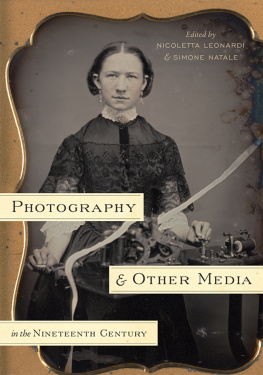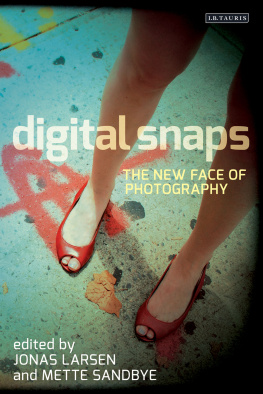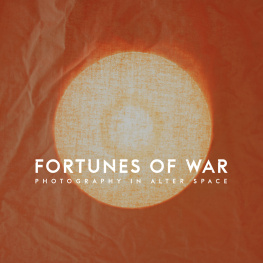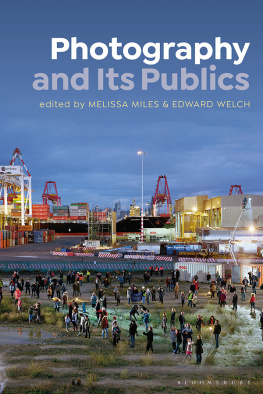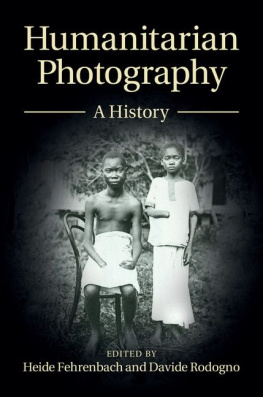PHOTOGRAPHY AND OTHER MEDIA
IN THE NINETEENTH CENTURY

P HOTOGRAPHY AND
Other Media in the
N INETEENTH C ENTURY
Edited by
Nicoletta Leonardi and Simone Natale
THE PENNSYLVANIA STATE UNIVERSITY PRESS
UNIVERSITY PARK, PENNSYLVANIA
.
Portions of of Geoffrey Belknap, From a Photograph: Authenticity, Science, and the Periodical Press, 18701890 (London: Bloomsbury Academic, 2016). Reprinted by permission of Bloomsbury Academic, an imprint of Bloomsbury Publishing Plc.
Library of Congress Cataloging-in-Publication Data
Names: Leonardi, Nicoletta, editor. | Natale, Simone, 1981 , editor.
Title: Photography and other media in the nineteenth century / edited by Nicoletta Leonardi and Simone Natale.
Description: University Park, Pennsylvania : The Pennsylvania State University Press, [2018] | Includes bibliographical references and index.
Summary: A collection of essays investigating photographys role in the evolution of media and communication in the nineteenth centuryProvided by publisher.
Identifiers: LCCN 2017032968 | ISBN 9780271079158 (cloth : alk. paper)
Subjects: LCSH: PhotographyHistory19th century. | Mass mediaHistory19th century.
Classification: LCC TR15 .P4795 2018 | DDC 770dc23
LC record available at https://lccn.loc.gov/2017032968
Copyright 2018 The Pennsylvania State University
All rights reserved
Printed in the United States of America
Published by The Pennsylvania State University Press, University Park, PA 16802-1003
The Pennsylvania State University Press is a member of the Association of American University Presses.
It is the policy of The Pennsylvania State University Press to use acid-free paper. Publications on uncoated stock satisfy the minimum requirements of American National Standard for Information SciencesPermanence of Paper for Printed Library Material, ANSI Z 39.481992.
C ONTENTS
NICOLETTA LEONARDI AND SIMONE NATALE
ERKKI HUHTAMO
SIMONE NATALE
DAVID M. HENKIN
RICHARD TAWS
NICOLETTA LEONARDI
LYNN BERGER
JAN VON BREVERN
STEFFEN SIEGEL
GEOFFREY BELKNAP
PEPPINO ORTOLEVA
ANTHONY ENNS
KIM TIMBY
ANDR GAUDREAULT AND PHILIPPE MARION
GEOFFREY BATCHEN AND LISA GITELMAN
This book is the fruit of an interdisciplinary collaboration between the editors that started through a lucky encounter. Around ten years ago, one of us, Simone, was working on a project in media history in which the history of photography had a meaningful part. He was wisely advised to talk with an art historian, Nicoletta, who had worked extensively on this subject. We would like to thank Peppino Ortoleva, one of the contributors in the volume, for encouraging this interdisciplinary encounter by putting us in contact with each other. It was the beginning of many conversations, first in Nicolettas apartment in Turin, Italy, then via Skype between different locations across Europe and North America, and finally at an Ethiopian restaurant in London.
We thank our contributors for taking up the challenge of thinking beyond established disciplinary boundaries and subjects. We also thank the many people who provided advice and encouragement during the project. Our editor, Ellie Goodman, was enthusiastic and supportive from the beginning and helped to make it possible; John Morriss careful editing helped make this a better book, along with the contribution of the staff at Penn State University Press, including Hannah Hebert, Jennifer Norton, Patricia Mitchell, and Laura Reed-Morrisson. We are thankful to Gabriele Balbi, Elizabeth Edwards, Lisa Gitelman, Joan Schwartz, and Jeremy Stolow for providing feedback and advice during the conception and development of the project, as well as to Michelle Henning and the second anonymous reviewer who provided exceedingly useful feedback on the first draft of the manuscript. Finally, thank you to Giulio Rossi and Thais Sarda for helping compile the bibliography and the alphabetical index.
In Media and the American Mind, a seminal work for cinema.
More than thirty years later, media history has become an established field of inquiry, supported by dedicated journals, associations, and conferences. Topics of interest to media historians include technologies as different as telegraphy, telephony, radio, television, film, sound recording, and digital media.history of photography and media is still much needed.
Conceived by two scholars who have different training and work in different disciplinary environments, art history and media studies, this book is built upon the assumption that a media history that fully and programmatically includes photography in its field of interest can make a substantial contribution to the discussion of the history of this medium. The word other in the volumes title, Photography and Other Media in the Nineteenth Century, is intended provocatively. It reflects the need to overcome artificial distinctions among individual media in favor of an integrated approach. In fact, the evidence and reflections collected here show that any medium is not just one thing but many, depending on its meanings and its uses, and demonstrate the need for further examination of photographys insertion into nineteenth-century media systems and cultures, as well as for consideration of its links and exchanges with the many other media of the time. Such endeavors promise to be stimulating and productive challenges for scholars in different disciplines, such as media historians, historians of photography, art historians, historians of science, visual and material anthropologists, material culture scholars, and cultural geographers.
Written from a cross-disciplinary perspective and having as its main object of inquiry the relationship between photography and other media, this volume moves away from the notion of an autonomous history of photography. It points to the opportunity of decentering the dominant narratives of canonical and new histories of photography, in the attempt to build a more inclusive, diversified, and empirically oriented approach to the study of photographs and photographic apparatuses. While this volume focuses on Western cultures and places, the contributors offer insights into the potentials and promises of a perspective that, we hope, will continue to be explored in the future, as the study of photography in Western and non-Western societies develops from different methodological, theoretical, and disciplinary viewpoints.
The book covers a time frame that runs roughly from the invention of photography (an event that, like most inventions, can only be arbitrarily dated, in this case to the year 1839) until the end of the nineteenth century. The borders of this periodization are flexible, however, and occasional excursions before and after these time limits are included. While starting with the introduction of photography might be an obvious choicealthough arguably a tricky one If ongoing processes of technological and institutional convergence in the digital age have stimulated scholars of photography to look beyond the borders of their discipline, this book serves as a reminder of the fact that photography and other media have been converging and mingling for a long timeindeed, they have always done so.
Both the 1830s1840s and the 1880s1890s are periods marked by what media historians have defined as explosive innovations in the field of communication. Photography, rapid typographical techniques powered by steam engines, the telegraph, and the postage stamp were introduced between the 1830s and the 1840s. At the end of the nineteenth century, photography was entirely redefined due to the emergence of new forms of collective entertainment, such as the cinematograph, along with the appearance of fast newspaper-folding machines; the linotype; the typewriter; the gramophone; Edisons media and practices. In pointing to the complex relationship between rupture and continuity, as well as between the old and the new, they offer an escape from the otherwise limiting boundaries of historical narratives based on the idea of technological revolutions.

